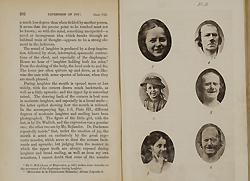The Books of Darwin
More Books continued

Girl and man smiling, in Charles Darwin, The expression of the emotions in man and animals, 1872
The Expression of the Emotions in Man and Animals (1872)
Darwin had explored the emotional life of humans and animals in The Descent of Man. He expanded his considerations in The Expression of the Emotions, produced from materials originally intended for that first work. Pioneering its use of photographs in science, Darwin relied on the images of artist Oscar Rejlander (1813-1875) to show the continuity of emotional life in the higher animals. By means of side-by-side pictures, Darwin was able to correlate human emotions with those shown by primates and other mammals. In doing so, he discredited the claim that humans had a distinctly different from the animals: the differences were ones of degree, not kind.
Other Works
Darwin’s works detailed his exploration of the lives of plants, demonstrating an organic complexity not previously appreciated. Piece-by-piece he built his case for evolution.
- The Variation of Plants and Animals under Domestication (1868)
- Insectivorous Plants (1875)
- The Movements and Habits of Climbing Plants (1875)
- The Effects of Cross and Self Fertilization in the Vegetable Kingdom (1876)
- The Different Forms of Flowers on Plants of the Same Species (1877)
- The Power of Movement in Plants (1880)
- The Formation of Vegetable Mold, through the Action of Worms (1881)
Last Reviewed: May 7, 2014


